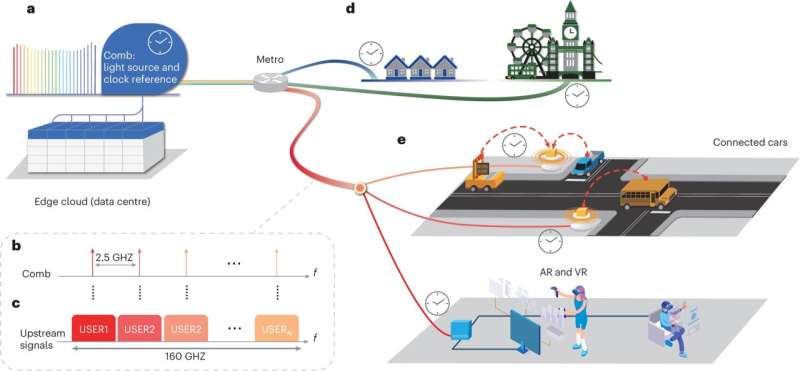Innovation paves way for driverless cars, drone fleets and significantly faster broadband

Unparalleled speed, capacity and reliability of new fiber broadband technology, invented by UCL researchers, could provide connectivity needed for applications of the future such as driverless cars and drone fleets.
The study, published August 28 in Nature Electronics, describes how the new telecommunications technology, called frequency referenced multiplexing, could provide more than 20 times the capacity of the best full fiber broadband networks available and 65 times the speed of typical current U.K. home broadband, along with a near-guaranteed connection and low latency.
Telecommunications networks are critical to the functioning of the Internet—they are the digital equivalent of roads carrying the data that connect us to the Cloud. The best networks use fiber optic cables to transmit and receive information. For the new full fiber broadband that is rolling out throughout the U.K., time division multiplexing (TDM) is the most common technology used to manage traffic, which combines the data of multiple users into one signal. Each user is assigned short time slots in which their data can be transferred in small chunks, before the data is reassembled at the destination.
The key issue with TDM is that each user’s data needs to wait for a time slot before it can be transmitted through the fiber, like cars waiting until they can drive onwards at traffic lights. With current technology, this approach has been necessary to coordinate transmission through the fiber, but this also limits the available data capacity and increases the time taken to send data through the network.
The fastest full fiber broadband services available in the U.K. offer upwards of one gigabit per second (Gb/s) download speed, usually with a much slower upload speed. Uptake of full fiber broadband has increased dramatically in recent years with the roll out of fiber optic connections to homes and businesses across the country, but for most U.K. broadband users, the final part of the line that goes into their homes remains older, slower copper wiring.
Consequently, the average broadband speed in the U.K. in September 2022 was just 65.3 megabits per second (Mb/s).
Demand for faster speeds and more reliable connections have also increased massively, from the rise of streaming on demand entertainment to the increase in videoconferencing use by people working from home since the COVID-19 pandemic. But certain applications of the future, such as driverless car networks, will require even higher speeds and near-guaranteed connections to operate safely and efficiently.
In this study, researchers from UCL developed frequency-referenced multiplexing to overcome the latency and bandwidth restraints of current approaches such as TDM.
They used optical and clock frequency synchronization, enabled by frequency comb and signal processing techniques, to provide each user with a dedicated optical channel. With this new approach, each user has the digital equivalent of their own dedicated road lane to communicate with the Cloud, with no need to wait at traffic lights. As a proof-of-concept, they set up a frequency referenced multiplexing system to provide up to 64 users with speeds of up to 4.3 Gb/s per user (or an aggregated speed of 240Gb/s for all users).
The authors hope that frequency-referenced multiplexing will be able to achieve more than 20 times the capacity and over 65 times the speed of current typical U.K. broadband. Because the user data is transmitted and received in parallel, this reduces the latency, power consumption, and capacity issues that arise with other approaches. This has the potential to lower the cost for future full fiber broadband, as well as increase the network availability and speed for every cloud user.
Associate Professor Zhixin Liu (UCL Electronic & Electrical Engineering), senior author of the study, said, “Some technology commentators are predicting networks of driverless cars and drone fleets in the not-too-distant future, all controlled from the Cloud. Our present telecommunications infrastructure isn’t equipped for such advancements, which necessitate guaranteed connectivity, minimal latency, synchronized clocks, and vastly improved speeds. Our research suggests that the frequency-referenced multiplexing approach can upgrade our fiber infrastructure to meet these technical demands.”
“In the short term, the technology has the potential to provide a much better home broadband service at a low infrastructure cost.”
More information:
Zichuan Zhou et al, Communications with guaranteed bandwidth and low latency using frequency-referenced multiplexing, Nature Electronics (2023). DOI: 10.1038/s41928-023-01022-x
Citation:
Innovation paves way for driverless cars, drone fleets and significantly faster broadband (2023, August 30)
retrieved 5 September 2023
from https://techxplore.com/news/2023-08-paves-driverless-cars-drone-fleets.html
This document is subject to copyright. Apart from any fair dealing for the purpose of private study or research, no
part may be reproduced without the written permission. The content is provided for information purposes only.
For all the latest Technology News Click Here
For the latest news and updates, follow us on Google News.

